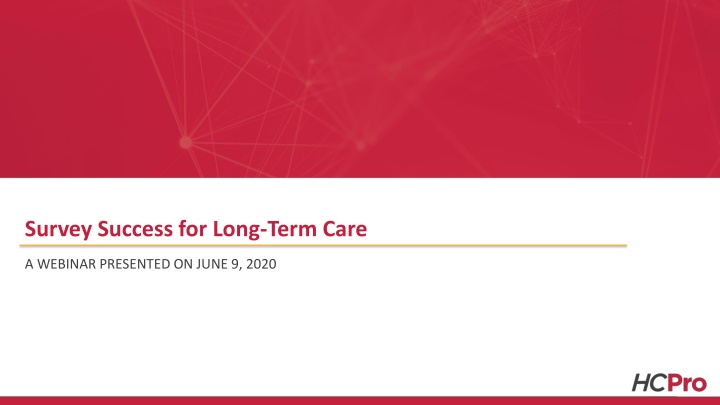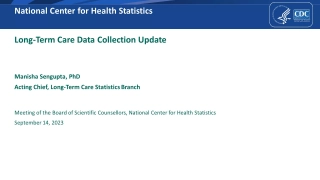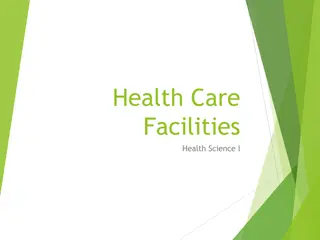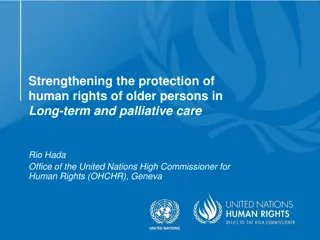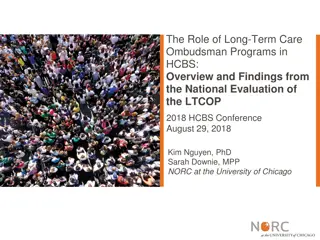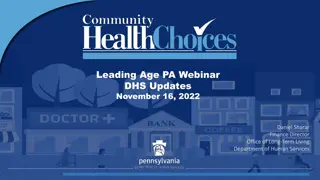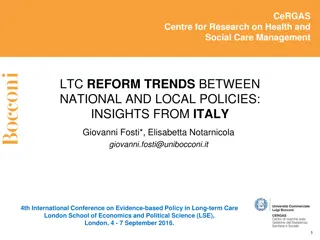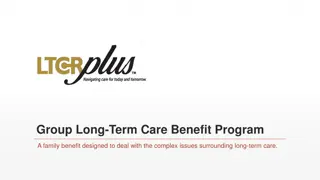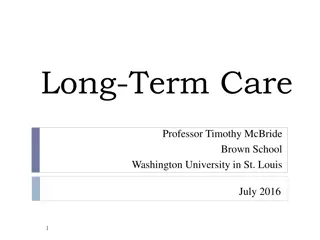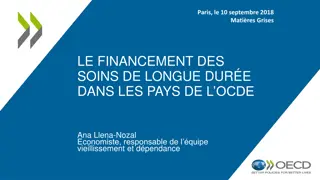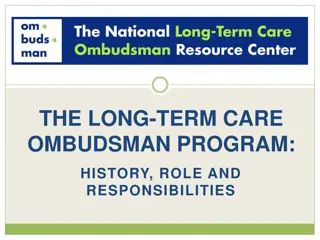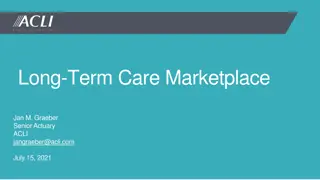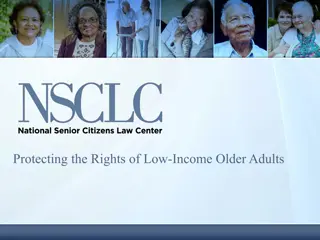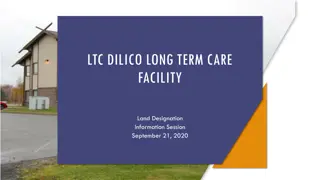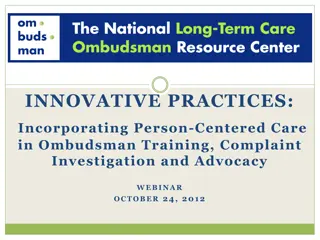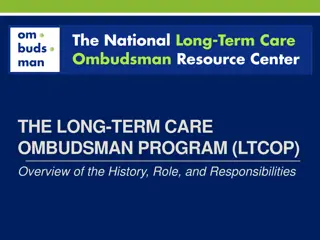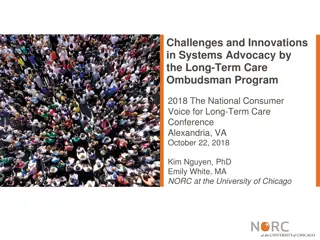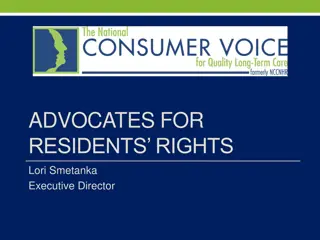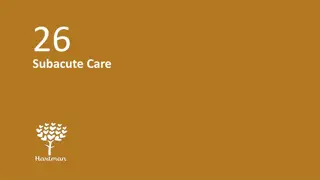Strategies for Long-Term Care Success
Dive into the world of long-term care with insights from industry experts during this informative webinar on survey success. Discover key compliance elements, risk areas, and how to develop a survey readiness plan for your organization. Learn about strategic opportunities tied to Star ratings and compliance history to enhance your market presence.
Uploaded on Mar 15, 2025 | 1 Views
Download Presentation

Please find below an Image/Link to download the presentation.
The content on the website is provided AS IS for your information and personal use only. It may not be sold, licensed, or shared on other websites without obtaining consent from the author.If you encounter any issues during the download, it is possible that the publisher has removed the file from their server.
You are allowed to download the files provided on this website for personal or commercial use, subject to the condition that they are used lawfully. All files are the property of their respective owners.
The content on the website is provided AS IS for your information and personal use only. It may not be sold, licensed, or shared on other websites without obtaining consent from the author.
E N D
Presentation Transcript
Survey Success for Long-Term Care A WEBINAR PRESENTED ON JUNE 9, 2020 1
Presented By Diane Hislop, RN, is the senior partner and chief operating officer for H2 Healthcare and the author of the HCPro book Survey Success for Long-Term Care: Reducing Citation Risk. Diane s practice area is clinical and compliance consulting. She has more than 30 years of clinical, executive, and consulting experience, primarily in specialty healthcare and the postacute segments of the healthcare industry. She is a graduate of Ball State University and is licensed as a registered nurse in 27 states. Diane has held numerous leadership roles in the postacute care industry, including her development of several clinical programs that were the first in the nation to be awarded all three JCAHO accreditations in long-term care; and her presence in the health law industry as a nurse consultant, where she has been recognized for her ability to consistently win cases at the informal dispute level and the appeal level. Diane is a recognized subject expert in forensic nursing and clinical compliance, and a frequent contributor to national publications. 2
Presented By Reginald (Reg) M. Hislop III co-founded H2 Healthcare, LLC in June of 2011. Reg s practice focus is strategy; health and economic policy; and business and corporate development. He has more than 30 years of experience as an executive and consultant in the development, operations, and financing of all aspects of healthcare, with particular experience in postacute care. Reg is the author of more than 250 published articles and research reports, as well as a frequent speaker on the national level and a consultant and advisor to numerous trade, investment, and professional organizations. His internationally read website on health policy is www.rhislop3.com. Speaker Photo Here 3
Learning Objectives At the completion of this educational activity, participants will be able to: Understand the new survey format and process Have a comprehensive understanding of the compliance elements and risk areas Be able to develop a survey readiness plan for their organization Integrate survey readiness into best practice/QAPI programs Understand the strategic opportunities/market opportunities associated with strong Star ratings and exceptional compliance history. 4
Todays SNF Survey Modified from the QIS survey Data driven CASPER, MDS, QMs Integrates past compliance history for focus (prior survey results, complaints) Uses Critical Element Pathways to address compliance patterns Interview driven Nearly half of the survey work occurs BEFORE surveyors come to the facility 5
Your Prep Matters Beginning Survey Readiness Watch your CASPER closely know the parts Facility details/flags Per resident detail Are flags due to performance or coding? Which residents help trigger? Go to their record and see why Explain via documentation, unusual occurrences or events that contribute to an event QAPI projects for trends identify and self- address weak/potentially non- compliant areas Identified past history of non-compliance 6
Your Prep Matters, continued Facility Assessment do the work; don t just grab a template! Use your CASPER and Roster Matrix to identify patient types and needs Build staff competencies to address the patient needs Correlate staffing numbers and skill level to the patient/resident profiles Watch your QMs and address the measures within your plan Survey Readiness Book Organized, tabbed and current! Resident Roster Staff Contacts Key Policies Facility Assessment Competencies Etc. 7
Survey Book 1st hour/on arrival Resident Roster Form 802 Census including bed holds List of residents by name/room Waiver/variances if any Facility map Key personnel contact list/info Current daily staffing sheets Med admin times New admits for past 90 days Discharges/transfers past 90 days Meal/menu info./dining location Residents with antipsychotic meds Residents on hospice List of residents with communication challenges (language, hearing, etc.) Residents 55 and younger Resident Council minutes, past 90 days and names of any officers Activity calendars past 90 days Admission contracts Written info. RE: Resident Rights Abuse/Neglect/Misappropriation policy Facility Assessment Policy/protocol re: accidents and incidents Residents receiving dialysis NEW: Residents with COVID/Respiratory Isolation 8
Survey Book: Within 24 hours Completed Census and Conditions Form 672 Completed LTC facility application New employees since prior survey with date of hire, title, whether currently employed Demand bill list last 6 months Residents with trust accounts/funds with facility Copy of surety bond CLIA waiver Volunteers with direct resident care roles List of paid feeding assistants 9
Slide Title Two Content Layout Example Lorem ipsum delor Undart wensetang is mebui Adioran is vancerait unes At deactre pir sellbany Duincre stat and vilananos Une wetang Lorem ipsum delor Undart wensetang is mebui Adioran is vancerait unes At deactre pir sellbany Duincre stat and vilananos Une wetang 10
Survey Book: 24 hours, policy section Standing Orders Infection Control with NEW: Pandemic Policy/COVID Policies/Protocols Influenza/Pneumococcal Immunization Social Media FDA/Pharmacy recalls Quality Assurance/QAPI Medication administration Oxygen Accident/Incident Investigations Abuse/Neglect/Misappropriation Other: Depending on resident characteristics, you may need additional policies that address issues such as language, personal preferences to incorporate sexual intimacy/sexual choice, ethnicity and culture, smoking, etc. 11
Survey Book: Within 24 hours, documents Maintenance supervisor name(s) Floor plan with smoke compartments labeled Emergency water agreement Fire alarm certification Electrical wiring certification Fire Department consultation reports Sprinkler system certification Location of sprinkler stock supply Range hood inspection Copy of any fire watch documentation since last survey Fire drills past 12 months Fire alarm monthly and annual inspections/testing/maintenance Smoke detectors testing Backflow (water) inspection Sprinkler testing records Generator tests and inspections Boiler inspection records Evacuation drills Flame spread certification for any new flooring, wall covering, drapes ,upholstered furniture, mattresses since last survey Emergency circuit/lighting testing Emergency supplies inventory and need calculation NEW: PPE stock and need testing (COVID) 12
Survey Book, 24 Hours, Environmental Policies Fire watch Smoking (residents and staff) Emergency supplies inventory and needs calculation NEW: PPE stock,preservation, type, protocol too (COVID) Evacuation plan Power strips Climate control emergencies Water outage Emergency Disaster Plan (including transfer/relocation/transportation agreements) Evidence/record of drills and education Emphasis: PANDEMIC Generator malfunction Infectious waste disposal 13
Survey: What to Expect, What to Have Done, What to Do On arrival critical for great first impression. Survey book, staff contacts, access to records (list of how charts/information is obtained, where located) Staff are prepped and ready Know where info is Know how to answer questions Know they can have support (no need to be cornered or alone) Know the residents Know key data such as QA info., where supplies are located, careplan/care card info., how policies/protocols work and where books are located, the disaster plan, infection control practices, etc. 14
They (Surveyors) know where they are going, do you? What are your weaknesses and who are your difficult families/residents? What does you CASPER and QMs tell you (trend, weaknesses)? What does your resident population look like? Anything strike you? Any disgruntled staff? Any recent contentious firings? Did they say complaint along with annual? Any unusual circumstances that were reported with bad outcomes? Do your QA processes help you or hurt you? Do you have QAPI plans in- place? Did you have prior citations with POCs and where are you now compared to then (did you achieve and maintain compliance)? 15
Survey Risks What are the Biggies Today? Infection Control welcome to the current and post reality world of COVID 19! Disaster planning see point above CASPER flags and lagging QMs Falls, Infections, Wounds, Weight Loss, ADL decline, pain, etc. Medications unnecessary, psychoactive, lack clinical substantiation, lack documentation of Black Box, inadequate pharmacy engagement (reviews) Resident Preferences/Personalization too institutional? Resident Council concerns, service wait times Staffing not a number; based on resident/patient need and profile tied by number and competency to facility assessment 16
Know the Risks Plan Accordingly! Integrate Compliance Risk Management Tasks/Functions Keep the Roster/Matrix current weekly update! MDS Assessment Reviews Decline/Improvement reports does charting support the coding, careplan changes, etc. QA/QM Reports 6 month comparison of like facilities trend analysis! Declines need focal efforts/QAPI plans/QAPI involvement Clinical Review a hybrid mini-QA focused entirely on resident/patient care issues in terms of falls, pain, complaints, significant changes, weight loss, infections, discharges, hospitalizations, admissions, etc. Data comes from 24 hour reports. Data is analyzed by an interdisciplinary team with the goal to rapidly address any problem/troublesome areas. 17
Know the Risks, continued Focused Meetings are Often Necessary Weekly pain meetings (especially with a focus on opioid use) Behavior meetings again, very focused on depression, agitation, atypical behaviors, sleep, etc. and medication use (goal is to minimize medication use) Falls/Accidents ASAP/within 24 hours focus is on finding root cause and deploying tailored, resident specific interventions QAPI Plan Meetings Team specific meetings for any QAPI plans that are operative. For example, a QAPI plan maybe in-place to reduce anti-depressants. This team may need to meet PRIOR TO a Behavior Meeting to provide results/updates in this meeting and then, to the QAPI Committee Staff Huddles Keep the staff current on initiatives and activities plus provide education and answer questions 15 min. max, typically at change of shift! 18
Use the Big Guns!...QAPI Your QAPI Program should be a compliance and survey readiness Super Tool! Meetings no less than bi-monthly (quarterly required, not enough) or even monthly! Track your key indicators! Falls, Pain, Infections, Meds, Weight Loss, Decline, Behavior, Call Light Response times, Resident Satisfaction, Transitions/Hospitalizations/ED visits, other Analyze, benchmark, discuss and plan for improvement target is always to be better than peers. Use research, best practice, outside resources, external/non-staff participants Integrate CNAs, Food Service, Environmental Service, Finance/Accounting, etc. Guard your data but don t be afraid to pull it out if need be to show surveyors how you address key issues and how you are on-top of issues! 19
Use the Big Guns!...Satisfaction Surveys/Customer Feedback Get ahead of complaints and demonstrate your outcome satisfaction! Hotline and email contact for any current concerns document and address. Keep a record Ask key service/critical element questions via paper, electronic and phone keep records Take the feedback to QA and seek process improvements where necessary Be public or publicly available with your satisfaction results (if credible and worthy) Key measures occur on admission, during the stay, on discharge, post-discharge at 5 day, 15 day and 30 day intervals can go even longer Key to address assess: Care satisfaction, service times, quality and environment questions around food, cleanliness, comfort, staff engagement, information, meet expecations . 20
Use the Big Guns!...Plan of Correction Reviews Unless your facility has maintained perfect compliance history, you had citations. Don t ignore or treat the correction as a paper compliance issue. POCs are a QAPI function Monitoring is key plus documentation Changes or updates plus resulting documentation Staff education and new competencies Ongoing assessment if the citation was serious and involved direct care (e.g, falls). Don t/can t one and done . Must keep an eye on the issue and track and trend between surveys, especially if the citation gridded at sub-standard care! Repeat non-compliance escalates remedies today! 21
The Compliance Tool Kit Survey Ready Audits are Key! Facility Assessment Walking Rounds Resident Rooms Resident Appearance Privacy and Dignity Staff Appearance Infection Control Dining Room/Dining Safety/Environemnt 22
Audits are Key, continued Careplan Audits MDS to Careplan Careplan to Care Card MDS and Documentation Does the documentation match the MDS assessment Does the care being delivered match the resident needs Admission Occurs 5 days after admission Are all assessments, careplans complete. Are meds accurate/med rec done. Medication Administration/Storage Completed by pharmacy 23
Audits are Key; a Few More Medical Records Current, complete Targeted toward high-risk patients from Roster Matrix Care Compliance Observational Is care completed per policy; are competencies being followed (e.g., infection control for PPE, handwashing, etc.) Mock Survey Done by skilled, competent third- party Conducted like a survey, only with teaching and discovery as the goal Worth every $$$ when good! 24
Managing it All Being successful is about a culture of compliance Being survey ready daily Focus on Quality! Use the tools, watch your QMs and CASPER QAPI is not an exercise Evangelize company-wide Line staff (nurses, CNAs, housekeepers, food service, etc.) Be willing to benchmark! Use outside resources for a robust approach 25
Whats Coming Next? The world of COVID and infection control Preventionist role Disaster plan Pandemic Policy Sharpen your infection control Phase 3 Ethics Infection Control Preventionist Staff Education/Staff Competency Other 26
COVID and Infection Control Right now, CMS is only conducting Infection Control Surveys All SNFs that have had COVID outbreak One third of those that haven t had COVID Scope is around infection control programs and the related components (influenza/pandemic policy, PPE protocols, employee and resident surveillance/tracking, etc.) 27
Infection Control Surveys Enhanced Enforcement (no recent Infection Control citation, since last standard survey) Non-Compliance not widespread (D & E) Directed Plan of Correction Non-Compliance, widespread (F) Directed Plan of Correction; DPNA (payment denial) discretionary, 45 days to demonstrate compliance 28
Infection Control Surveys Enhanced Enforcement (recent infection control citation history in the last year) Non-Compliance not widespread (D & E) Directed Plan of Correction, DPNA discretionary, 45 days to correct, up to $5,000 CMP per State/CMS discretion Non-Compliance, widespread (F) Directed Plan of Correction; DPNA (payment denial) discretionary, 45 days to demonstrate compliance, $10,000 per instance CMP 29
Infection Control Surveys Enhanced Enforcement (recent infection control citation of two or more violations in the last two survey cycles) Non-Compliance not widespread (D & E) Directed Plan of Correction, DPNA discretionary, 30 days to correct, $15,000 per instance or per day as long as the total CMP exceeds $15,000 Non-Compliance, widespread (F) Directed Plan of Correction; DPNA (payment denial) discretionary, 30 days to demonstrate compliance, $20,000 per instance or per day as long as the CMP exceeds $20,000 30
Infection Control Surveys Enhanced Enforcement (actual harm violations regardless of Infection Control citation history) Non-Compliance at Level G, H, I: Directed Plan of Correction, DPNA discretionary, 30 day to comply/correct. CMP imposed at the highest non- IJ level, per CMP analytic tool Non-Compliance at Leve J, K, L: Directed Plan of Correction plus mandatory Temporary Manager or Termination, DPNA discretionary, 15 days to comply/correct. CMP imposed at the highest IJ appropriate range, per CMP analytic tool. 31
The Strategic Levers Great Compliance = Opportunity Marketability Narrow Networks Narrowing Networks Hybrids ACOs Payer Mix Financial Performance Staff retention/recruitment Lower insurance costs Lower interest costs 32
A Systematic Approach Compliance and being survey ready starts with building great systems Making resident outcomes the priority Policies and other tools Competent, well-educated leadership Staff education and competencies Audits (we talked about this) Satisfaction and feedback loops QAPI Is Deficiency Free possible? YES .More so today as information and outcomes are at the forefront of the survey tasks be prepared! 33
Questions! Tools are available via the book Survey Success for Long-Term Care Available on the HCPro marketplace 34
